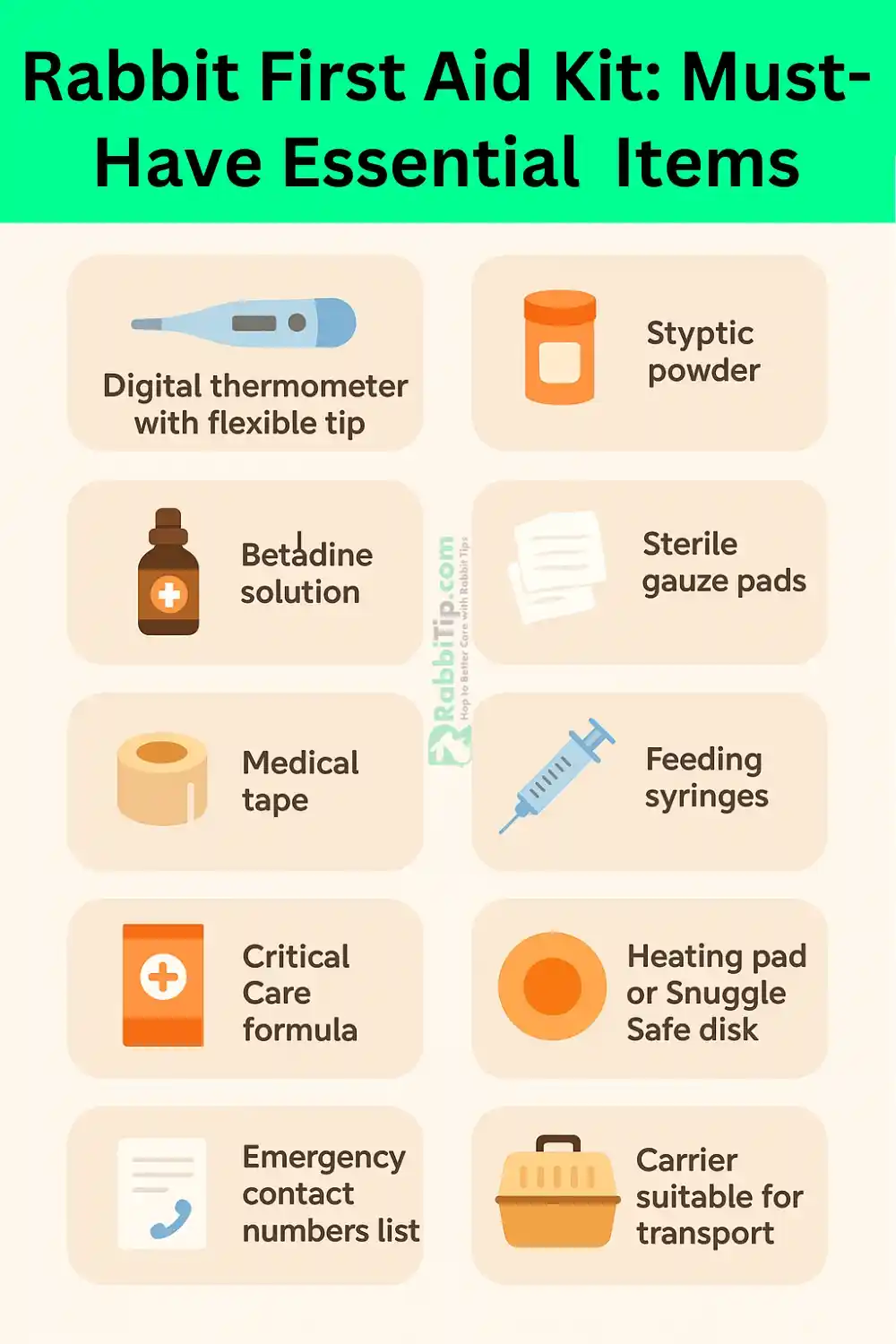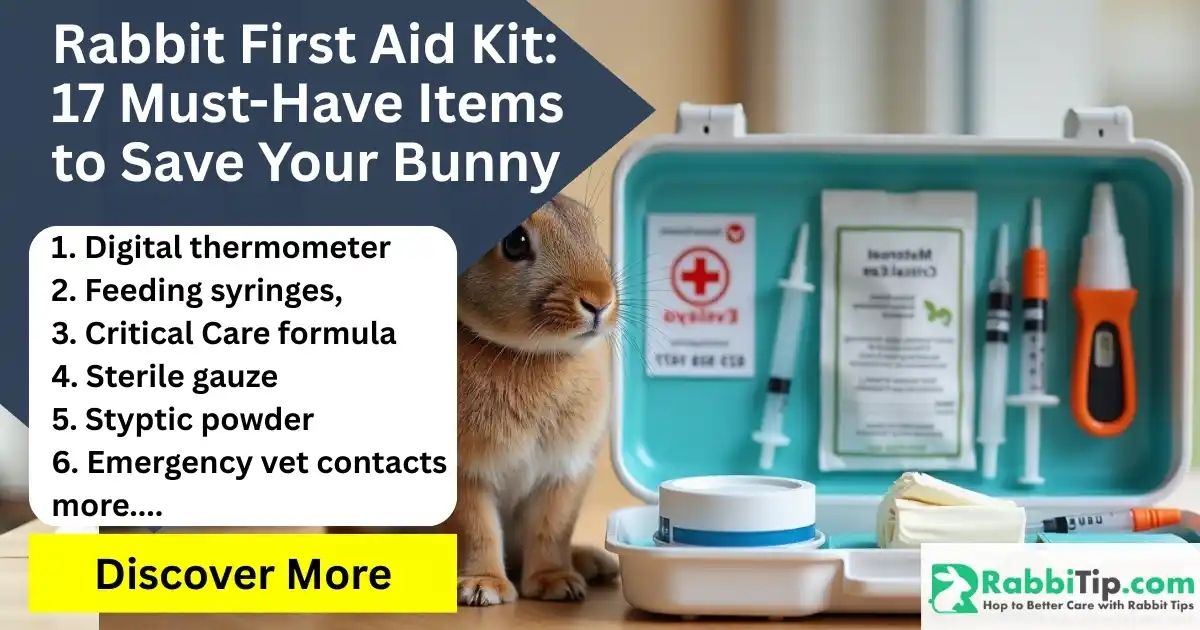Every rabbit owner must keep a first aid kit with these core items: digital thermometer, feeding syringes, Critical Care formula, sterile gauze, styptic powder, and emergency vet contacts.
Rabbit emergencies can happen suddenly. Fast action is vital when your bunny stops eating, gets injured, or shows signs of illness. A ready kit saves time and stress.
Your kit should include wound care items like gauze and antiseptic, feeding tools for GI stasis, and a thermometer for quick checks. Keep all supplies fresh, easy to reach, and know how to use them before an emergency happens.
For full safety, stock AVMA-approved items that follow American veterinary standards. Quick access to the right tools can make the difference between life and death for your rabbit.
Emergency Response Checklist (Printable):
- Check breathing and pulse
- Assess for bleeding or injury
- Monitor body temperature
- Contact the emergency vet immediately
- Begin appropriate first aid measures
Rabbit first aid and care kit
AVMA-Approved Supply Checklist includes 17 essential items every American rabbit owner should stock. Professional veterinarians recommend these specific supplies based on the most common rabbit emergencies seen in US veterinary clinics.
Core medical supplies:
- Digital thermometer with flexible tip – Essential for checking fever or hypothermia. Normal rabbit temp is 101-103°F.
- KY jelly lubricant for temperature checks – Makes rectal temperature taking easier and safer for your bunny.
- Styptic powder for bleeding nails – Quickly stops nail bleeding from overgrown or damaged claws during trimming.
- Betadine solution for wound cleaning – Antiseptic that safely disinfects cuts and scrapes without stinging.
- Sterile gauze pads (2×2 and 4×4 inches) – Covers wounds and absorbs blood. Multiple sizes handle different injuries.
- Medical tape (paper or cloth) – Secures bandages without pulling fur when removed. Choose gentle adhesive types.
- Saline solution for eye/wound irrigation – Flushes debris from eyes and cleans wounds safely without irritation.
- Feeding syringes (10ml and 20ml) – Force-feed sick rabbits who stop eating. Critical for preventing GI stasis.
- Critical Care formula for herbivores – Complete nutrition powder that mixes with water. Prevents dangerous weight loss.
- Small scissors with rounded tips – Cuts tape and gauze safely. Rounded tips prevent accidental cuts during emergencies.
- Tweezers for splinter removal – Removes thorns, splinters, or debris from paws and fur safely and precisely.
- Heating pad or SnuggleSafe disk – Prevents shock by maintaining body heat. Use low settings to avoid burns.
- Small towels for restraint – Wraps nervous rabbits safely during treatment. Provides comfort and prevents escape.
- Emergency contact numbers list – Quick access to 24-hour vets, poison control, and regular veterinarian contact info.
- Recent medical records copy – Vaccination history and health info for emergency vets who don’t know your rabbit.
- Carrier suitable for transport – Safe, secure transport to the emergency clinic. Include soft bedding for comfort.
- Flashlight with extra batteries – Examines wounds in poor lighting. Essential during power outages or night emergencies.

Core Medical Supplies:
American-made product recommendations include Johnson & Johnson gauze pads and 3M medical tape. These brands meet FDA standards for veterinary use. Quality supplies ensure better outcomes during rabbit emergencies.
Steps when your Rabbit is sick
Emergency Response Protocol follows these numbered steps:
- Assess the situation immediately – Check if your rabbit is breathing normally
- Take vital signs – Normal temperature ranges from 101-103°F
- Contact your emergency vet – Use our emergency vet locator tool for 24-hour clinics
- Begin appropriate first aid – Stop bleeding, support breathing, maintain warmth
- Prepare for transport – Secure carrier with soft bedding
- Monitor continuously – Watch for changes during transport
USDA-recommended monitoring techniques include checking gum color, listening to breathing sounds, and feeling for abnormal lumps. Document all symptoms with times for your veterinarian. Quick action often determines the outcome of rabbit emergencies.
Never delay professional care for home treatment alone. While first aid helps stabilize your rabbit, veterinary intervention remains crucial for serious conditions. Keep your vet’s contact information easily accessible in your first aid kit.
Emergency kit contents
US veterinary standards require specific items for rabbit emergency preparedness. Professional exotic animal veterinarians emphasize having supplies ready before emergencies occur. This approach follows American emergency preparedness protocols established by leading veterinary organizations.
| Item | Purpose | AVMA Rating |
|---|---|---|
| Digital Thermometer | Temperature monitoring | Essential |
| Styptic Powder | Stop nail bleeding | Essential |
| Critical Care Formula | Nutrition support | Essential |
| Sterile Gauze | Wound dressing | Essential |
| Betadine Solution | Antiseptic cleaning | Essential |
| Feeding Syringes | Force feeding | Essential |
| Heating Pad | Temperature support | Essential |
| Medical Scissors | Cutting materials | Recommended |
| Saline Solution | Eye/wound irrigation | Recommended |
| Emergency Blanket | Shock prevention | Optional |
Packing a Bunny Go-Bag
Emergency evacuation requires portable supplies that travel easily. American disaster preparedness guidelines suggest keeping emergency kits in waterproof containers. Quick access during natural disasters or unexpected moves protects your rabbit’s health and safety.
| Solution | Use | Safety Rating |
|---|---|---|
| Infant gas drops | Bloat relief | Vet-approved |
| Pumpkin puree | Digestive aid | Safe |
| Pedialyte | Hydration support | Diluted only |
| Honey | Energy boost | Minimal amounts |
| Chamomile tea | Calming effect | Cooled completely |
| Apple cider vinegar | pH balance | Highly diluted |
My preference: mostly natural and home solutions
Natural remedies complement professional veterinary care without replacing medical treatment. Home solutions provide immediate support while arranging professional care. Always consult your veterinarian before using alternative treatments for serious conditions.
| Symptom | Immediate Action | Vet Required |
|---|---|---|
| Not eating 12+ hours | Syringe feed Critical Care | Yes – same day |
| Soft stool | Increase hay, reduce pellets | If continues 24hrs |
| Hard breathing | Keep cool, reduce stress | Yes – immediate |
| Bleeding nail | Apply styptic powder | If bleeding continues |
| Eye discharge | Saline rinse | If discharge thick |
| Lethargy | Check temperature | If temp abnormal |
Veterinary care during the pandemic: What pet owners should expect
Pandemic protocols changed how American veterinary clinics operate emergency services. Many clinics now require appointments for non-critical cases. Emergency visits still receive immediate attention for life-threatening conditions.
COVID-19 Safety Measures:
- Curbside drop-off for routine care
- Limited client entry for emergencies
- Enhanced sanitation between patients
- Telemedicine consultations when appropriate
- Extended wait times due to reduced capacity
Emergency Flowchart:
Rabbit Emergency → Call Clinic → Describe Symptoms →
Receive Instructions → Transport Safely → Follow Up Care
Medical supplies
Professional-grade medical supplies ensure proper emergency care quality. FDA-approved products meet safety standards for animal use. Stock supplies before emergencies occur – pet stores may close during disasters or late-night emergencies.
Wound Care Essentials:
- Sterile gauze in multiple sizes
- Medical tape that sticks well
- Antiseptic solutions for cleaning
- Antibiotic ointment (vet-prescribed)
- Bandage scissors for cutting materials
Temperature Management:
- Digital thermometer for accurate readings
- Heating devices for hypothermic rabbits
- Cooling methods for overheated animals
- Insulation materials for transport
Support food and hydration
Rabbits stop eating during stress or illness. Nutritional support prevents dangerous GI stasis. Keep feeding supplies fresh and easily accessible. Replace expired formula every six months.
Feeding Emergency Supplies:
- Critical Care powder for complete nutrition
- Large syringes for easy feeding
- Mixing bowls for formula preparation
- Clean water for formula mixing
- Electrolyte solutions for dehydration
Natural Food Options:
- Fresh herbs like parsley and cilantro
- Banana pieces for a tempting appetite
- Apple slices without seeds
- Leafy greens for hydration
- Hay cubes for convenient feeding
Household Items
Common household items serve as emergency medical supplies. Keep these items separate from regular household use. Label everything clearly for quick identification during stressful situations.
Multi-Purpose Items:
- Clean towels for restraint and comfort
- Flashlights for examining wounds
- Plastic containers for transport
- Rubber gloves for sanitary handling
- Permanent markers for labeling
USDA-approved sanitation protocols include washing hands before and after handling sick rabbits. Use separate tools for each rabbit to prevent disease spread. Clean all equipment with approved disinfectants after emergency use.
FAQ
What should be in a rabbit first aid kit?
A complete kit has wound care supplies (gauze, antiseptic), feeding tools (syringes, Critical Care), temperature tools (thermometer, heat pad), and emergency info (vet numbers, records).
What 7 items should be in a first aid kit?
The seven most critical items are: digital thermometer, feeding syringes, Critical Care formula, sterile gauze, styptic powder, heating device, and emergency vet contact information.
What to put on a rabbit wound?
First, flush with sterile saline. Then, clean with a Betadine solution diluted to the color of weak tea. Cover with sterile gauze. Never use hydrogen peroxide or alcohol—they damage tissue.
What essentials do rabbits need?
Beyond emergency kits, daily essentials are unlimited: Timothy hay, fresh water, quality pellets, a large enclosure, and daily exercise and social time.
Download our complete bunny care sheet for detailed requirements.
How to handle rabbit emergencies after hours?
Locate a 24-hour emergency exotic vet now, before you need one. Program their number into your phone. Save this article’s printable checklist. Preparation is power.
Use our emergency vet finder to identify nearby facilities. Call ahead to confirm rabbit treatment availability. Transport your rabbit in a secure carrier with soft bedding. Bring your first aid kit and medical records to the emergency clinic.
Red Flag Symptoms Requiring Immediate ER Visit:
- Complete loss of appetite over 12 hours
- Difficulty breathing or mouth breathing
- Severe bleeding that won’t stop
- Inability to urinate or defecate
- Loss of coordination or falling over
- Body temperature below 100°F or above 104°F
Additional Resources:
- Emergency preparedness requires planning ahead with quality supplies
- Consider multiple adorable bunny names when expanding your rabbit family
- Professional veterinary relationships ensure the best emergency outcomes
External Authority References:
–American Veterinary Medical Association Emergency Guidelines
Remember that preparation saves lives. Stock your rabbit first aid kit today and review its contents every six months. Replace expired medications and refresh perishable items regularly. Your rabbit’s health depends on your emergency preparedness.

